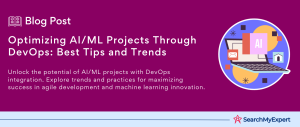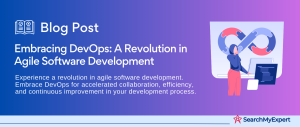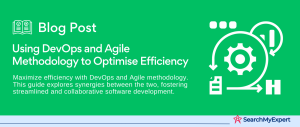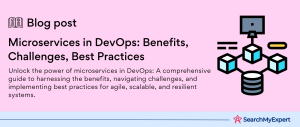DevOps: Revolutionizing Software Development and Operations
In the ever-evolving landscape of software development, DevOps stands as a transformative approach, blending the practices of development (Dev) and operations (Ops) into a cohesive and streamlined process. This synergy is not just a set of practices but a philosophy that reshapes the way teams collaborate and software is delivered.
Understanding the DevOps Philosophy
At the heart of DevOps lies a commitment to collaboration and automation, breaking down the traditional silos between the development and operations teams. This alignment is not merely about working alongside each other; it’s about integrating their workflows, tools, and mindsets to foster a culture of shared responsibility, transparency, and faster feedback loops.
Core Principles of DevOps
- Continuous Integration/Continuous Delivery (CI/CD):
This principle advocates for regular merging of code changes into a central repository, followed by automated testing and deployment. It ensures a smoother, quicker path from development to deployment. - Automation:
From code testing to deployment, automation is key in DevOps. It minimizes human error, accelerates processes, and maintains consistency in operations. - Monitoring and Feedback:
Continuous monitoring of the deployed software allows for immediate feedback, ensuring any issues are addressed swiftly, thus maintaining the stability and performance of applications. - Collaborative Culture: Emphasizing a culture of collaboration, DevOps encourages open communication and sharing of ideas, tools, and responsibilities between the development and operations teams.
Benefits of Adopting a DevOps Approach
- Enhanced Software Delivery Speed:
By integrating and automating the development and operations processes, DevOps significantly reduces the software delivery time, enabling businesses to respond faster to market changes and customer needs. - Improved Quality and Stability: Continuous testing and feedback loops ensure that the quality of the software is maintained, and issues are resolved quickly, leading to more stable releases.
- Increased Efficiency: Automation in testing and deployment processes reduces manual efforts, leading to increased efficiency and productivity.
- Better Collaboration and Morale: The collaborative nature of DevOps enhances team morale and productivity, as teams work in unison towards a common goal.
Pillars of DevOps: Tools and Technologies Shaping Modern Software Development
DevOps, a paradigm shift in software development and operations, is underpinned by an array of tools and technologies. These pillars not only facilitate collaboration but also ensure efficiency, reliability, and continuity in the software delivery process. Let’s explore these critical elements that form the backbone of DevOps.
Version Control Systems (VCS): The Bedrock of Collaboration
- Essence of VCS: Version Control Systems like Git are fundamental in managing and tracking changes to software code. They allow multiple developers to work on a single project without conflicting, ensuring a harmonized workflow.
- Git – A Prime Example: Git, known for its efficiency and flexibility, is the most widely used VCS in DevOps. It facilitates branching and merging, enabling developers to work independently on features and later merge changes without disrupting the main codebase.
Continuous Integration/Continuous Delivery (CI/CD): Streamlining Development to Deployment
- Automation of the Software Lifecycle:
CI/CD tools automate stages from code building and testing to deployment, ensuring that software can be reliably released at any time. - CI/CD Pipelines:
Tools like Jenkins, CircleCI, and Travis CI enable the creation of pipelines that automatically build, test, and deploy code changes, thus accelerating the release cycle and reducing manual errors.
Configuration Management: Consistency Across Environments
- Role of Configuration Management Tools: Tools such as Ansible, Chef, and Puppet play a pivotal role in managing and automating the configuration of servers and systems, ensuring consistency across different environments.
- Benefits:
These tools enable infrastructure as code (IaC), allowing teams to automate the provisioning and management of infrastructure, leading to faster, more efficient, and error-free deployments.
Monitoring and Observability: Keeping a Pulse on Performance
- Importance of Monitoring Tools: Tools like Prometheus, Grafana, and the ELK Stack (Elasticsearch, Logstash, Kibana) provide insights into application performance and infrastructure health.
- Functionality: These tools help in identifying and diagnosing issues in real time, ensuring high availability and performance of applications and services.
Cloud Technologies: Enabling Scalability and Flexibility
- Cloud Platforms in DevOps: AWS, Azure, and Google Cloud Platform (GCP) offer an extensive range of services that support DevOps practices. They provide scalable resources, managed services, and automation capabilities.
- Advantages:
The cloud empowers teams with flexibility, allowing them to quickly provision resources as per demand, optimize costs, and focus on innovation rather than infrastructure management.
Security and Compliance: Integrating DevSecOps
- Integrating Security into DevOps:
Security is an integral part of DevOps, often referred to as DevSecOps. It involves incorporating security practices and tools throughout the DevOps lifecycle. - Tools and Practices:
Tools like SonarQube for code quality and vulnerability scanning, and container security platforms like Aqua Security, ensure that security is baked into the code from the initial stages.
Automation Tools and Techniques: Enhancing Efficiency in DevOps
In the realm of DevOps, automation stands as a cornerstone, essential for streamlining processes and reducing manual workloads. This section delves into the pivotal automation tools and techniques that have revolutionized how DevOps tasks are executed.
Scripting Languages: The Power of Automation Scripting
- Role of Scripting in DevOps: Scripting languages like Python, Bash, and Ruby are indispensable in automating repetitive DevOps tasks. These languages enable the creation of powerful scripts that can automate a range of processes from code deployment to system monitoring.
- Python – A Versatile Choice:
Python, known for its simplicity and readability, is widely used for automating tasks, data analysis, and infrastructure management. - Bash and Ruby:
Bash, a Unix shell scripting language, is commonly used for automating command-line tasks. Ruby, with its simple syntax, is often utilized for building automation tools and web applications.
Infrastructure as Code (IaC): Revolutionizing Infrastructure Management
- Defining IaC: IaC is a practice that involves managing and provisioning infrastructure through code instead of through manual processes.
- Terraform – A Leading IaC Tool: Terraform, an open-source IaC tool, enables users to define and provision a data center infrastructure using a declarative configuration language. This approach ensures that the infrastructure deployment is repeatable and consistent.
- Advantages of IaC: IaC enhances efficiency, reduces the potential for human error, and ensures consistency across environments. It allows for easy tracking of infrastructure changes and simplifies the process of scaling and managing infrastructure.
Containerization: Streamlining Application Deployment
- Understanding Containerization:
Containerization involves encapsulating an application and its dependencies into a container that can run on any computing environment. This ensures consistency across different environments, from development to production. - Docker – A Game-Changer in Containerization:
Docker has emerged as a key player in containerization, providing an easy and efficient way to create, deploy, and run applications using containers. - Kubernetes:
Orchestrating Containers: Kubernetes, often used alongside Docker, is an open-source system for automating deployment, scaling, and management of containerized applications. It simplifies the management of containerized applications at scale.
Continuous Integration/Continuous Delivery (CI/CD) Pipelines: Streamlining Software Delivery
The CI/CD pipeline is a fundamental aspect of DevOps, serving as the backbone for automating the software development process. It enables developers to deliver code changes more frequently and reliably. Let’s break down the stages of a CI/CD pipeline and explore some popular tools that facilitate this process.
Stages of a CI/CD Pipeline
- Code Commit:
This is the initial stage where developers commit code changes to a version control repository, often triggering the CI/CD process. - Build: In this stage, the committed code is compiled or transformed into executable code. This might involve compiling source code, packaging binary code, and preparing application assets.
- Test: Automated tests are run to validate the integrity and functionality of the code. This includes unit tests, integration tests, and other forms of automated testing to ensure code quality.
- Deploy:
If the build and test stages are successful, the code is deployed to a staging or production environment. This step may be automated or require manual approval, depending on the workflow. - Post-Deployment Monitoring:
After deployment, continuous monitoring of the application in the production environment is essential to quickly identify and address any issues.
Popular CI/CD Tools
- Jenkins:
An open-source automation server, Jenkins is widely used for building, testing, and deploying software. It’s highly customizable with a vast plugin ecosystem. - GitLab CI/CD:
Integrated into the GitLab platform, GitLab CI/CD provides a seamless experience for repository management, along with CI/CD functionalities. - Travis CI:
A cloud-based CI/CD service, Travis CI is known for its ease of integration with GitHub, providing automated testing and deployment for projects hosted there.
Benefits of CI/CD Pipelines
- Faster Release Cycles: CI/CD pipelines automate most of the software delivery process, significantly speeding up the release cycle and enabling continuous delivery of updates to customers.
- Improved Code Quality: Regular and automated testing ensures that bugs and issues are caught and addressed early in the development process, leading to higher-quality software.
- Enhanced Developer Productivity:
Automation of repetitive tasks frees developers to focus on more valuable activities, boosting productivity and innovation. - Reduced Deployment Risks:
Frequent and incremental changes mean smaller code changes per release, reducing the risk associated with deployments. - Better Feedback Loops:
Continuous integration and delivery allow teams to get immediate feedback on their work, leading to quicker improvements and adjustments.
Monitoring and Observability in DevOps: Ensuring System Reliability and Performance
In the DevOps world, monitoring and observability are critical for maintaining the health and efficiency of applications and infrastructure. While closely related, these concepts have distinct roles in a DevOps environment. This section explores these roles, the tools used for monitoring and observability, and their importance in troubleshooting and debugging.
Understanding Monitoring and Observability
- Monitoring:
This refers to the process of collecting, analyzing, and using data to track the performance and health of applications and infrastructure. Monitoring focuses on known issues and key metrics to maintain system health. - Observability:
Observability extends beyond monitoring by providing insights into the internal state of systems through external outputs. It is about understanding the “why” behind system behavior, particularly for troubleshooting and debugging.
Monitoring Tools
- Application Performance Monitoring (APM):
Tools like New Relic and AppDynamics provide insights into application performance, helping to identify bottlenecks and optimize response times. - Infrastructure Health Monitoring: Solutions like Nagios and Zabbix are used to monitor server health, network performance, and other infrastructure components to ensure they are functioning optimally.
- Log Monitoring:
Tools such as Splunk and the ELK Stack (Elasticsearch, Logstash, Kibana) help in aggregating, searching, and analyzing log data, which is crucial for understanding events and patterns within the system.
Observability Tools
- Distributed Tracing:
Tools like Jaeger and Zipkin offer distributed tracing capabilities, essential for understanding the behavior of microservices and complex architectures. - Time-Series Data Analysis:
Prometheus, coupled with Grafana for visualization, is commonly used for time-series data monitoring, providing critical insights into system performance over time. - Real-Time Analytics:
Real-time observability tools enable immediate insights into system performance and user interactions, facilitating quick responses to emerging issues.
Importance of Monitoring and Observability
- Rapid Troubleshooting and Debugging: By providing deep insights into system behavior, monitoring, and observability tools enable teams to quickly identify and address issues, reducing downtime and improving user experience.
- Proactive Issue Resolution:
These tools allow for the proactive identification of potential issues before they impact users, ensuring higher system reliability and availability. - Informed Decision-Making:
The data and insights provided by monitoring and observability tools inform decision-making processes, helping in capacity planning, performance optimization, and risk management.
Challenges and Best Practices in DevOps Implementation
DevOps, while transformative, is not without its challenges. Overcoming these challenges is key to leveraging its full potential. This section discusses common hurdles in DevOps adoption and outlines best practices for a successful implementation, complemented by real-world examples.
Common Challenges in DevOps Implementation
- Cultural Change:
Shifting to a DevOps culture requires a significant mindset change. Teams accustomed to working in silos may find it difficult to collaborate closely and share responsibilities. - Integration of New Tools and Technologies: Integrating and adapting to new tools can be a challenge, especially for teams used to traditional development and operations methods.
- Skill Gaps: DevOps demands a wide range of skills, and finding or training personnel who are adept in both development and operations can be challenging.
- Continuous Improvement:
DevOps is an ongoing process of learning and improvement, which can be overwhelming for teams used to more static workflows.
Best Practices for DevOps Adoption
- Foster a Collaborative Culture: Encourage open communication and collaboration between development and operations teams. Emphasize shared goals and responsibilities.
- Gradual Implementation:
Start small with DevOps practices and gradually scale up. This allows teams to adapt to new workflows without feeling overwhelmed. - Continuous Learning and Training: Invest in training and development programs to upskill teams in DevOps tools and practices. Encourage a culture of continuous learning.
- Choose the Right Tools:
Select tools that best fit your organization’s needs and integrate well with existing workflows. Avoid overcomplicating with too many tools. - Automate Where Possible:
Automate repetitive tasks to improve efficiency and reduce the scope for human error. - Implement Feedback Loops:
Establish feedback mechanisms to continuously learn and improve processes.
Examples of Successful DevOps Implementations
- Technology Sector:
Companies like Netflix and Amazon have successfully implemented DevOps, resulting in faster deployment cycles, reduced downtime, and enhanced customer satisfaction. - Finance Sector:
Financial institutions like Capital One have adopted DevOps to improve their software delivery process, enhance security, and stay competitive in the digital age. - Retail Industry: Walmart is an example of a retail giant that has embraced DevOps, leading to improved online customer experiences and streamlined operations.
The Future of DevOps Tools and Technologies: Emerging Trends and Speculations
The landscape of DevOps is continually evolving, driven by emerging technologies and changing market demands. Let’s explore some of the most prominent trends in the field of DevOps and speculate on how these innovations might shape its future.
Emerging Trends in DevOps
- Artificial Intelligence and Machine Learning (AI/ML):
AI and ML are increasingly being integrated into DevOps tools for smarter automation, predictive analytics, and enhanced decision-making. AI can automate complex tasks, predict failures, and optimize resource allocation. - Microservices Architecture: Microservices, which involve breaking down applications into smaller, independent services, are gaining traction. This approach offers greater scalability, flexibility, and faster deployment times compared to traditional monolithic architectures.
- Serverless Computing:
Serverless architectures, where cloud providers manage the server infrastructure, are becoming more popular. This approach enables developers to focus solely on writing code, as the infrastructure management is handled by the cloud provider.
Speculating the Future of DevOps Tools and Practices
- Increased AI-Driven Automation:
AI/ML will likely play a more significant role in automating and optimizing various DevOps processes, from code integration and deployment to monitoring and problem resolution. This will lead to more efficient workflows and faster time-to-market. - Evolution of Microservices Tools:
As microservices become more prevalent, we can expect a surge in tools designed to manage these architectures, including more advanced service meshes, container orchestration platforms, and microservices-specific monitoring tools. - Rise of Serverless DevOps:
With the growing adoption of serverless computing, DevOps tools will evolve to better support serverless architecture, focusing on deployment strategies, performance monitoring, and cost management in a serverless environment. - Shift towards End-to-End Automation:
The future of DevOps will likely see more comprehensive automation solutions that cover the entire software development lifecycle, from planning and coding to testing, deployment, and operations. - Enhanced Security Integration:
As DevOps continues to evolve, there will be a stronger focus on integrating security practices directly into the DevOps workflow, leading to the more widespread adoption of DevSecOps. - Greater Emphasis on Observability:
With the increasing complexity of modern software systems, observability will become even more crucial. Tools that provide deeper insights into system performance and user experience will see significant advancements.
Conclusion:
The world of DevOps is a dynamic and ever-evolving field, crucial for the modern software development and IT operations landscape. Through this comprehensive exploration, we’ve delved into the core aspects of DevOps, from its foundational principles and benefits to the diverse array of tools and technologies that drive efficiency and innovation. We’ve navigated through the intricacies of CI/CD pipelines, the practicalities of automation tools, and the criticality of monitoring and observability, all while keeping an eye on the future with emerging trends like AI/ML, microservices, and serverless computing.
The journey through DevOps is not just about adopting new tools or technologies; it’s about embracing a culture of collaboration, continuous improvement, and a relentless pursuit of operational excellence. As we look ahead, the integration of advanced technologies and practices will undoubtedly continue to reshape and redefine the DevOps landscape, making it an exciting field for IT professionals and organizations alike.
Partner for IT success with leading DevOps Service Agencies.
Table of Contents
Toggle






